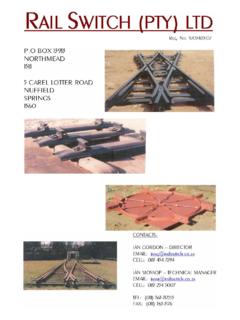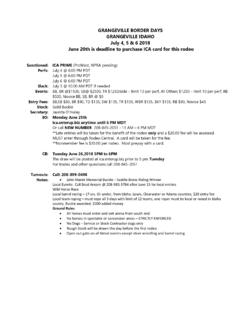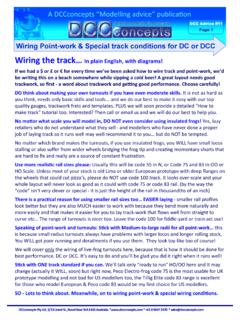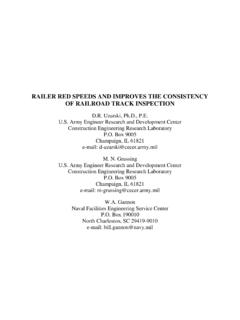Transcription of TRACKWORK doing it right - Scenic Express
1 1 doing it rightA clinic by Rich Kolm 2006 PCR Convention River City Express in SacramentoINTRODUCTIONW hether you are new to model railroading or have beenaround for a while, this quick review of TRACKWORK designand construction should give you some useful ideas andinsights. It covers the things that are important for reliable,trouble-free operation of trains while creating a more-realisticappearance. The purpose is enjoyment of this great are given for HO scale, but the informationapplies to the other scales as well. Track planning handbooksand the NMRA standards and recommended practices coverall the popular scales. The mention of proprietary products andspecific publications is only for information and does notrepresent any regarding TRACKWORK design and constructionis on the Internet and experience with TRACKWORK design andconstruction is shared at various online discussion operation is many things TRACKWORK , even when carefully designed and properlyconstructed, is only one of the things that can affect reliable,trouble-free operation of trains.
2 The other important things(not covered in this clinic) include the following: Equipment. Locomotives must be mechanically in goodworking order; passenger and freight cars should be ofoptiumum weight based on standard formulas; wheels must betrue and properly gauged; truck-mounting screws must beadjusted for good tracking without car wobble; and couplersshould be installed at the correct height and working properly. Electrical. Provide enough electrical connections to thetrack to assure no loss of power; feed the rails from electricalbuss wires under the layout, especially with DCC; don tdepend on rail joiners for electrical connections; turnoutsshould not have any electrical breaks nor potential for shortcircuits; track has to be kept clean; and good electrical pickupon locomotives is a must. If your control system is DCC, turnouts that are DCC friendly are an advantage. Maintenance. Track and turnouts should be checked forproper gage and flangeway widths, especially at switch points,frogs, and guard rails; be sure rail joints are smooth andaligned; mounting of trucks and couplers on cars andlocomotives must be periodically checked and readjusted ifnecessary; and the wheels of locomotives and cars should bekept DESIGNC urvesJust as with real railroads, there are several factors thathave to be considered in laying out curves: minimum radius,spiral curves, superelevation, and s-curves.
3 Minimum Radius. If prototypical radii were used for amodel railroad, the space required would be tremendous. InHO scale, the minimum radii would be:Mainlines130 Mainlines in mountains100 Branch lines70 Sidings and yards50 Obviously, there has to be a compromise. Larger radiiwould be closer to the prototypical dimensions, would give arealistic appearance, and would provide smooth example, in HO scale a radius of 48 or larger would beideal. However, we have to use smaller radii to accommodatethe limited space confronting most layouts. The followingcriteria apply in HO scale:Preferred minimum radius 32 Conventional radius24 Sharp curve radius18 Spiral Easements. A train making the sudden changefrom a tangent (straight track) to a curve (fixed radius) looksunrealistic. The locomotive may lurch, especially steam. Theends of longer passenger and freight cars will have asignificant lateral offset, as shown in Figure 1. This isespecially true with the smaller radii curves we use on modelrailroads.
4 Wheels may not track smoothly and car-mountedcouplers can be significantly misaligned, causing derailment. Train operation will look more realistic and will besmoother by creating a spiral easement a curve of gradually2 Curves, continueddiminishing radius connecting the tangent (straight track) withthe curve (fixed radius). NMRA Data Sheet D3c describesseveral ways of doing it cubic spiral calculation (theprototype approach), tangent method, bent-stick method, andthree-segment template bent-stick method is very simple, with the stepsshown in Figure 2. Working with track centerlines, first offsetthe fixed-radius curve from the tangent and establish thetransition length. Tack one end of the stick along the tangentand then bend the stick to match the fixed radius of the curveat the end of the transition length. The track centerline canthen be drawn along the stick. Spiral Easement Dimensions in HO ScaleRadius ofTransitionOffsetCurveLengthDistance18 12 3/8 24 16 7/16 32 20 1/2 Superelevation.
5 You probably have observed the visualeffect of superelevation or banking of curves on real locomotive and train lean to the inside of the curvebecause the outer rail is raised higher than the inner rail tocounteract the tendency of a train to overturn outward,especially at higher speeds. The prototype superelevation maybe as much as 6 ( for HO scale) but is usually is usually not important to the operation ofmodel trains. However, it does add a lot to the realisticappearance of a train rounding a curve. The suggestedsuperelevation is in HO scale (about 1/32 ), whichseems small but is visually subgrade and roadbed are installed with a level cross-section. Then the outside rail of the track can be raised with1/32 wood strips or styrene strips glued onto theroadbed under the ties. Flex track is also available with built-in superelevation. If the track subgrade is on risers, the tops ofthe risers can be cut or set at the appropriate very small angle,but this is difficult to gradual transition is required from no superelevation onthe tangent to full superelevation on the curve.
6 The location ofthis transition is the same as a spiral easement transition (seeFigure 2). S-Curves. The problem of car ends being offset wherethe track changes from tangent to curve (Figure 1) can becompounded by an S-curve, particularly when the tangent(straight track) between the two curves is very short. It canalso be a problem for longer wheelbase steam with very short tangents should be avoided inthe design of TRACKWORK , particularly with sharper , the tangent should be at least as long as the longestfreight or passenger crossover between two parallel tracks, as shown inFigure 3, is a tight S-curve that cannot be avoided. However,the tangent length between frogs can be increased forsmoother train operation by using longer turnouts with asmaller frog angle and a larger closure radius. For example,with a #6 crossover the tangent is which is increased with #8 turnouts . But at the same time, the spacerequired the length of the crossover in Figure 3 increasesfrom for #6 to for # is a turnout a switch?
7 Turnout is the term usedin the railroad industry for the TRACKWORK device that allowsflanged wheels to move from one track to another. Peopleoperating the railroads refer to the switch, which is only themoveable switch-point rails the route is changed bythrowing the switch . Size (number). The sizeof a turnout is represented by anumber (#4, #6, etc) which isdetermined by the angle atwhich the rails cross at the frog,How that number relates to thefrog angle is shown in Figure 5. Closure radius is thecenterline radius of the middlepart of the curved leg betweenthe switch point rail and thefrog. The maximum possibleclosure radius for a given frogangle is a matter of geometry. Itis an important consideration inthe design of TRACKWORK andideally should not be less thanthe minimum radius your rollingstock will easily take. Lead is the length fromthe point of the frog to thepoint-end of the switch pointrails (Figure 4). NMRA dimensions.
8 Thedata in the table below are forHO scale based on the standarddimensions in NMRA of model railroadturnouts sometimes make the lead length shorter and thus theclosure radius smaller than these standard # 14 15 15 # 11 25 26 # 9 32 43 # 8 10 49 # 7 09 67 # 5 43 117 # 4 46 151 Moveable switch point rails in the North Americanprototype are most-often fabricated with straight rails on bothlegs of the turnout. On the curved leg the switch point railmakes an angle of about 1 or 2 when the point is against thestraight stock rail, which is a sudden change for turnouts may have a slightly curved switch point rail onthe curved leg because the turnouts are small compared to theprototype. Both rails are straight going through the frog. Selecting turnouts and their sizes to use on a modelrailroad takes takes into account a number of factors: era being modeled what rail size and design? type of railroad main line or branch line?
9 Appearance of TRACKWORK does it have the quality to look like the prototype? reliable train operation does it properly fit the track configuration and the size of rolling stock? space available what are the layout limitations?Some prefabricated turnouts may not be DCC friendly (see Figure 17). This is not required, but does assure more-reliable operation of trains. It avoids momentary electricalshorts caused by metal wheels not tracking properly andassures a continuous power feed and control signal tolocomotives. For more information see the websites listed onpage 1. Space Limitations. The selection of turnouts fordifferent layout situations is usually a compromise in modelrailroading because most layouts have limited LineYardsprototype turnout#10 to #20#8 or longertypical model railroad #6 to #8 #4 to #8 Longer turnouts (larger number) are more prototypical,have a more realistic appearance, and provide smootheroperation on the curved leg.
10 On the other hand, shorterturnouts (smaller number) can better utilize limited space andmay be acceptable for operation of shorter engines and and curved turnouts and double-slip switches can be usedto optimize the use of layout space, but on the prototype areusually used only where train speeds are slower such as inyard areas. Prefabricated turnouts may not always fit into thedesired TRACKWORK configuration; however, scratch-builtturnouts can be crafted to provide exactly what s , continued Minimum size turnouts . Considering appearance andreliable train operation, the minimum size turnouts for a modelrailroad are recommended as follows. Use longer turnouts ifspace line crossovers#8main line sidings#8branch lines (shorter cars and engines)#6yards for 70 -85 cars#8yards for 40 -70 cars#6yards for shorter freight cars#5industrial sidings in tight places#4 Location. When designing a layout, the location ofturnouts is very important for reliable and smooth operationand realistic appearance.







